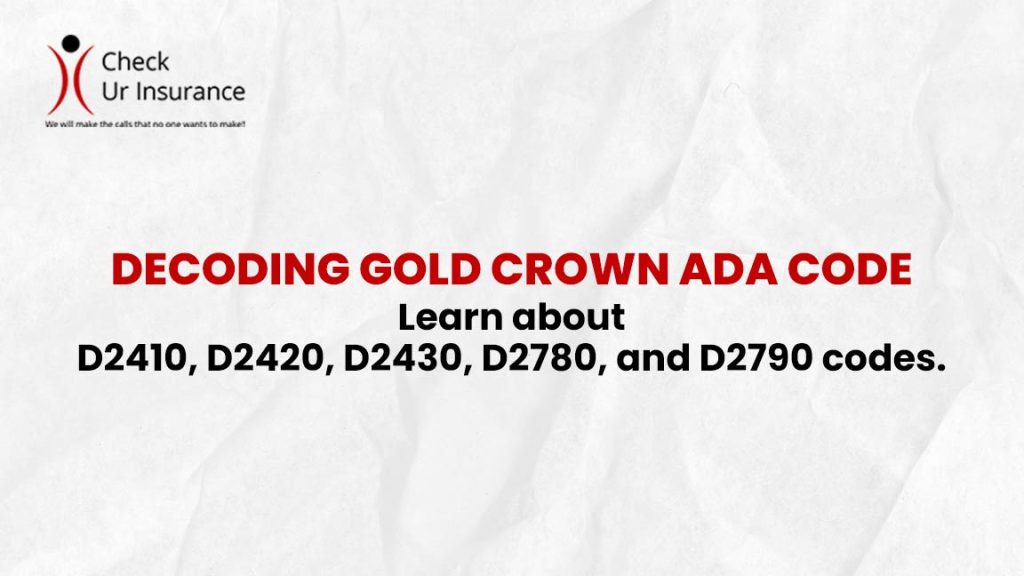Decoding Gold Crown ADA Code: Comprehensive Guide
Gold foil has stood the test of time as one of the oldest forms of restoration for cavities. This technique utilizes the unique properties of gold, known for its cohesive and biocompatible nature. This article explores the various Gold Crown ADA Codes, shedding light on their applications in modern dentistry.
Table of Contents
Understanding Gold Crown ADA Code
D2410: Gold Foil, One Surface
The D2410 ADA code is specific to gold foil restoration involving a single surface. Dentists employ this technique by placing sheets of gold leaf into the cavity, leveraging gold’s cohesive properties for effective dental repair.
D2420: Gold Foil, Two Surfaces
For more extensive decay, the D2420 code comes into play, covering gold foil restoration on two surfaces. This involves the meticulous placement of gold leaf sheets to address decay affecting multiple surfaces of a tooth.
D2430: Gold Foil, Three Surfaces
In cases of further complexity, the D2430 ADA code is utilized for gold foil restoration on three surfaces. This meticulous procedure ensures comprehensive coverage and effective treatment for advanced decay.
D2780: 3/4 Cast High Noble Metal Crown
Moving beyond fillings, the D2780 code is associated with a 3/4 cast high noble metal crown. This prosthetic crown, constructed entirely of high noble metal, covers three-quarters of the tooth’s surface, providing a durable and aesthetically pleasing solution.
D2790: Full Cast High Noble Metal Crown
D2790 dental code signifies a full cast high noble metal crown. In this procedure, the prosthetic crown is entirely constructed of high noble metal, including gold. It covers the entire remaining portion of the tooth, ensuring robust and lasting dental restoration.
Exploring Additional ADA Codes
In addition to gold foil and crowns, several other ADA codes pertain to dental restorations involving high noble metals:
- D6210: Pontic (Part of Bridge) – Cast High Noble Metal
- D6602: Retainer Inlay – Cast High Noble Metal, Two Surfaces
- D6603: Retainer Inlay – Cast High Noble Metal, Three or More Surfaces
- D6610: Retainer Onlay – Cast High Noble Metal, Two Surfaces
- D6611: Retainer Onlay – Cast High Noble Metal, Three or More Surfaces
- D6780: Retainer Crown (3/4 Cast High Noble Metal)
- D6792: Retainer Crown – Full Cast Noble Metal
Each of these codes corresponds to specific dental procedures involving high noble metals, contributing to various aspects of restorative dentistry.
FAQs about Gold Crown ADA Code
What is the D2410 ADA code used for?
The D2410 ADA code is employed for gold foil restoration on a single surface of a tooth, addressing decay with precision.
Is the dental code D2790 suitable for full tooth coverage?
Yes, the D2790 ADA code signifies a full cast high noble metal crown that covers the entire remaining portion of the tooth.
Are there alternatives to gold foil restoration?
Alternatives include porcelain and ceramic restorations, but gold foil remains a durable and biocompatible option.
How long does a gold crown typically last?
Gold crowns, constructed using D2790, are renowned for their durability, often lasting 15 years or more with proper care.
What factors should one consider when choosing between D2780 and D2790?
Choosing between a 3/4 cast crown (D2780) and a full cast crown (D2790) depends on the extent of tooth coverage needed and aesthetic preferences.
Can gold foil be used for multiple surfaces?
Yes, the D2430 ADA code specifically addresses gold foil restoration on three surfaces, catering to more extensive decay.
Conclusion
Understanding the nuances of gold crown ADA codes, particularly D2410, D2420, D2430, D2780, and dental code D2790, empowers individuals to make informed decisions about their dental care. These codes represent a rich tapestry of options, each catering to specific dental needs for effective and lasting results.
Did you like this article? Read more helpful latest blogs.

